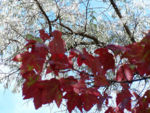White willow
| White willow |
|---|

|
| Scientific Classification |
|
| Binomial Name |
|
Salix alba |
White willow, directly from the name, usually belongs to the Salicaceae family. In the earth, there are about 300 to 400 species of willow, however white willow, purple willow, and crack willow are just used remedially. [1] White willows grow in Southern, Northern and Central Europe, North America, and Asia. It is a giant tree that can grow up to 20 to 30 meters tall. The name "White willow" originates from the leaves that are paler than other willows, usually due to a covering of silky white hairs, especially on the underside. The leaves are 1 to 2cm and 5 to 10cm wide. [2]
Ecology
White willow generally is bred from hardwood cuttings in winter or from semi-ripe cuttings in summer. The trees are commonly cropped and the bark is usually stripped from branches of 2 to 5-year old trees during spring to summer. Native of Europe, white willow is generally distributed in North America and Asia, thriving in damp areas like on river banks. [3]
Medical Uses
White willow bark usually decreases fever, eases pain, decreases heart attack and stroke, and eases inflammation. White willow bark also aids in decreasing the onset of some cancers.[4] German Commission has agreed to recommend white willow for remedying fevers, headaches and other pain. White willow is used to treat bad headaches, toothache pain, and muscle sprains. The British Herbal compendium has managed (administered) white willow as a treatment for inflammation of a joint and Asian influenza. [5] Often, White willow bark is used in the same way as aspirin. Aspirin was generally made from White willow bark. [6]
The active ingredient in white willow is salicylic acid. It has a synergistic effect when combined with EphT1 (Ephedra) to help the thermogenic process (the fast conversion of the food we digest into heat). The internal bark of the tree was harvested for salicin that was changed to salicylic acid, but an alternative form (acetylsalicylic acid) is now synthetically made. In white willow bark, the salicylic acid usually reduces the body’s levels of prostaglandins a hormone that is responsible for pain or inflammation. Because of the lower incidence of side effects combined with the herb, many herbalists prefer the white willow to use that of artificial aspirin. [7]
History
Early Chinese physicians started to use white willow for reduce pain in about 500-550 B.C., and that used up to this day. However, it usually took 5 centuries for that affect to work its way to Europe.
By the 18th century, white willow bark was used to treat some kinds of sorts of fevers, such as a pain reliever. Early colonists usually brought in the tree to North and South America and discovered many Indian tribes using the native willow barks to treat pain or fever. In 1828, German and French chemists took out (extract) white willow's active chemical which is salicin. About ten years later, one of Italian chemist purified the aspirin precursor, it’s salicylic acid. Actually, this potent pain reliever was first found in white willow, but chemists created the first aspirin form another herb. By 1839, salicin was discovered in meadowsweet.
During the 19th century, researchers proved both salicylic acid and salicin relieve pain, fever and inflammation. After few years, chemists made acetylsalicylic acid aspirin; it’s from salicylic acid obtained from meadowsweet. The idea was to maintain (preserve) the benefits of salicylic acid while minimizing its side effects. Aspirin finally became the household medicine. [8]
Related References
- Introduction of White willow
- White willow Multiple authors, Wikipedia
- White willow Kundalini-tantra
- White willow Indian spring herbs
- White willow Herbs2000
 Browse |



